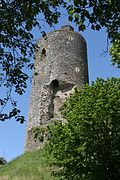|
Vouvant
Vouvant (French pronunciation: [vu.vɑ̃]) is a commune in the department of Vendée, in the Pays de la Loire region in western France. Vouvant is labelled as Les Plus Beaux Villages de France (since 1988), Petites Cités de Caractère, and the village has obtained two flowers out of five in the Concours des villes et villages fleuris. It is the only remaining fortified town in the Vendée. Its inhabitants are called Vouvantais. Over 10% of the population of Vouvant is British owing to a gradual occupation or purchase of real estate by English families. Sites and monumentsSeveral sites and monuments are present in Vouvant :
See alsoReferences
Wikimedia Commons has media related to Vouvant.
Information related to Vouvant |
||||||||||||||||||||||||||||||||||||||||||||||


















